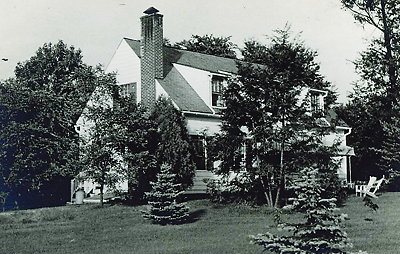As a resident at Chestnut Lodge in Rockville, Md., “David” was not unlike many with schizophrenia at the famed institution—his illness was chronic and longstanding, he had been treated unsuccessfully with the few medications then available for psychosis, and the Lodge was not the first institution he had been to.
For Thomas McGlashan, M.D., the young psychiatrist assigned to him, David was a vexation and, in time, an illuminating case study. Trained at Massachusetts Mental Health Center, McGlashan was drawn to the Lodge for its emphasis on intensive psychoanalytic treatment of psychosis. “I was told `if you really want to do this kind of work with psychosis, the Lodge was the place to be,’ ” McGlashan recalled.
So he analyzed unconscious motives and transferences and attempted to engage David in a therapeutic dialogue about his past and its relationship to his present difficulties; silence or evasion in therapy was interpreted as resistance.
But David’s inability to engage was stubborn and began to seem less like a psychological symptom than a reflection of a neurological deficit. And his delusions were painful—for patient and therapist alike. “His voices were clearly torturing him,” McGlashan said. “After a while I started him on neuroleptics. That really made a difference—he still hallucinated, and the hallucinations were dysphoric, but they weren’t terrifying.”
The Lodge was psychoanalytically oriented but open to experimentation, and McGlashan began to change his tactics. He let David enjoy the silence between them during therapy and instead concentrated on building the rudiments of an interpersonal relationship of the kind the patient had never had. They took walks together around the grounds of the hospital; later David earned privileges to leave for brief shopping trips in town on which McGlashan would accompany him.
“Just being able to be with someone—a real person, not an inquiring therapist—was in itself a therapeutic goal,” McGlashan recalled. “I became essentially a companion.”
It was a case example of how the approach to psychosis at the Lodge would change in coming years. In 1986, McGlashan hired Robert Heinssen, Ph.D., a cognitive-behavioral psychologist, as a research coordinator, and in time Heinssen would help organize an institution-wide treatment strategy for schizophrenia that combined antipsychotic medications with cognitive interventions, social skills training, psychiatric rehabilitation, and supported employment in the community.
Today, McGlashan and Heinssen remember their experience at Chestnut Lodge as formative, laying the groundwork for an approach to schizophrenia emphasizing psychosocial and rehabilitative services to target what came to be understood as “negative symptoms”—avolition, poor cognitive function, lack of affect, and anhedonia—combined with the use of neuroleptic medication to treat positive symptoms of delusions, hallucinations, and disorganized thinking.
Most important, the legacy of intensive, one-on-one work with patients at the Lodge would underscore the developmental nature of schizophrenia. And the rich case histories of patients who passed through the institution—nearly always revealing signs of trouble that might have been apparent very early in patients’ lives, well before the onset of acute psychosis—would inform a new movement focused on early identification and intervention in the “prodromal,” or preclinical, stage of the disorder.
Today, both men are leaders and champions of that movement, which started in Australia and has grown to include research projects in Europe and North America that promise to dramatically alter the trajectory of schizophrenia.
In an interview with Psychiatric News, Heinssen noted that it was another Chestnut Lodge luminary—Harry Stack Sullivan, M.D.—who very early on presaged this direction in a prescient comment in 1927. “The psychiatrist deals with too many end states and deals professionally with too few of the prepsychotic [states]…,” Sullivan wrote in The Onset of Psychosis. “With this in mind it would seem we should lay great stress on the prompt investigation of failing adjustment, rather than, as is so often the case, wait and see what happens…. I feel certain that many incipient cases might be arrested before the efficient contact with reality is completely suspended, and a long stay in institutions made necessary.”
Lodge Begins to Change Course
When McGlashan arrived at the Lodge in 1975, its renown had been established in part because of the work of Frieda Fromm-Reichman, M.D., a contemporary of Sigmund Freud and one of the ȳmigrȳ analysts who fled Europe during World War II; Fromm-Reichman was the real-life counterpart to the fictional “Dr. Fried” in I Never Promised You a Rose Garden, the best-selling autobiography by a former patient at the Lodge.
At the time, the Lodge was a 70- to 80-bed hospital with seven inpatient units and a day hospital. McGlashan recalled that patients were routinely treated without medication (few drugs were available then for psychosis). “It was rationalized that most of the patients had been overmedicated,” he said. “Drugs were viewed as the enemy because they dulled the mind and inhibited feelings that were necessary to access in therapy.”
But out of the experience of treating David and other patients, a pattern emerged, and McGlashan began to believe that the silences, inability to engage, and apparent lack of motivation were somehow intrinsic to the illness—rather than manifestations of “resistance” to therapy. In the 1980s he launched a long-term follow-up study of patients at the Lodge and in 1986 published a landmark paper that came to a dispiriting conclusion—roughly two-thirds of the schizophrenia patients were functioning marginally or worse at follow-up (see related story).
Heinssen arrived at the Lodge that same year as a research coordinator; trained in cognitive-behavioral therapy, he was “an odd duck” among psychoanalysts at the Lodge, where there was little else in the way of structured therapy. Called to participate in a case conference for a patient whose family was extremely dissatisfied with the progress of treatment, he recalled that an outside consultant had recommended a more structured treatment plan built around social learning theory and a rehabilitative approach that would require the active involvement of nurses and staff as “change agents.”
Heinssen liked the idea and suggested that a sub-unit of the hospital be dedicated as a behavioral treatment program for schizophrenia, using the consultant’s recommendations, and in 1988 the Lodge initiated a pilot program. The success of the program led the medical director—Dexter Bullard, M.D., whose family had owned the hospital since the turn of the century—to make the behavioral unit permanent, and in 1990 Heinssen was appointed director of behavioral treatment.
The principles used in the inpatient unit were later adopted as a guiding philosophy for the institution’s approach to treating schizophrenia, and—partly owing to McGlashan’s follow-up findings—Heinssen contributed to the transformation of Chestnut Lodge in its last years of existence from a long-term residential facility devoted to psychoanalysis, to one offering a continuum of services including cognitive therapy, rehabilitation and social-skills training, partial hospitalization, and supported housing and employment in the community.
At the same time, the seeds of a new movement aimed at early intervention and prevention of acute psychosis began to take root in Australia with the work of Patrick McGorry, M.D., who advocated staged treatment of at-risk individuals in the preclinical phase of the illness.
It caught the attention of McGlashan who had come to the same conviction, an insight made possible by the psychoanalytic method and the highly individualized treatment approach at the Lodge. “For all of the patients who were admitted to the Lodge, there was this fantastically rich developmental data set that raised the question, `When did the disorder start?’ These records went way back [in each patient’s history] and were very detailed,” McGlashan said. “You could tell that in almost every case something started going wrong three or four years or more before the first psychotic break.”
And when McGlashan left the Lodge in 1990 he resolved that the “prodrome”—the distinctive and lengthy risk period prior to acute psychosis—would become the focus of his work.
Heinssen, too, shared this conviction and the imperative to begin looking “upstream” earlier in the developmental narrative of schizophrenia was brought home in a poignant dialogue with the mother of a patient who had been treated at the Lodge. Invited by a local chapter of the National Alliance for the Mentally Ill to speak about the innovations he had helped bring about at the Lodge, Heinssen recalled the conversation. “This woman’s son had `graduated’ from the behavioral program, he had started community college, he had a part-time job and was living in an apartment in the community,” Heinssen told Psychiatric News. “I’m thinking to myself, `this is a great outcome.’ But when his mother continued to speak to me, she burst out crying. She told me, `I know I should be grateful, but I can’t help thinking about what might have been.’ ”
Seeking the Human Behind the Disease
Today, Heinssen is the National Institute of Mental Health’s science officer for the North American Prodrome Longitudinal Study, a nine-site consortium of clinical research programs dedicated to the early detection and prevention of psychotic disorders and other forms of serious mental illness. McGlashan has been a leading investigator in the ongoing Early Treatment and Intervention in Psychosis (TIPS) study in Scandinavia, and developed the Scale of Prodromal Symptoms, which is used to assess at-risk individuals for inclusion in early-intervention programs.
The Bullard family sold the Chestnut Lodge property in the 1990s, and the hospital closed in 2001. The property changed hands several times before a developer purchased it with the intention of converting the property into condominiums; but on the morning of June 7, 2007, the main building burned to the ground under mysterious circumstances.
Its ruins—the old cottage where Fromm-Reichman lived still stands—persist as a monument to an extraordinary and heroic effort to understand the individual behind the psychotic disorder, an individual with a history and a human story that might have taken a different turn.
“There were some phenomenal teachers and therapists there,” Heinssen said. “To the uninitiated, people with psychosis can appear alien, and it is no surprise that they get pushed away. There is something extraordinarily unsettling about interacting with someone who experiences a different reality. But at the Lodge there were many heroic doctors and nurses who sought to find the human being behind the disease. They taught me to look beyond psychotic symptoms and to connect with the real person who has a soul and value and worth.” ■


